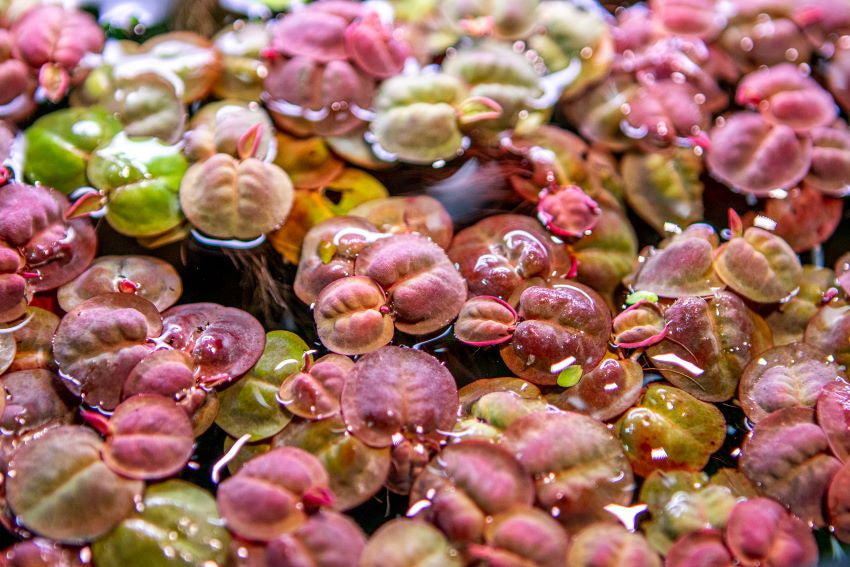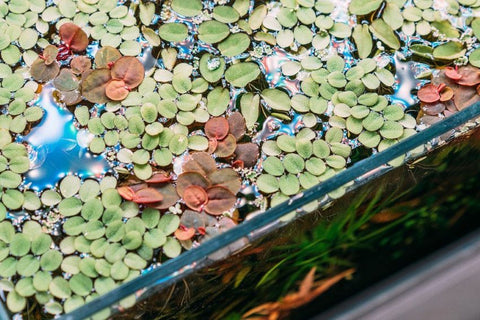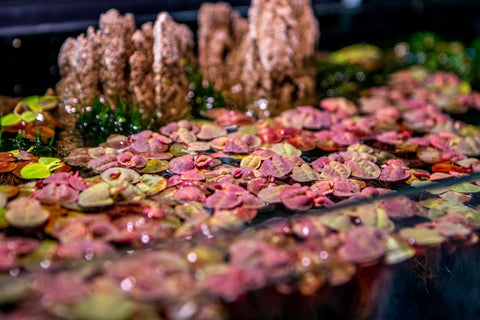
Red Root Floaters: Care Guide
Family name: Phyllanthaceae
Origin: South America
Red Root Floaters, or Phyllanthus Fluitans, are a freshwater floating fern plant known in the aquascaping game for their unique look, deep red roots, and easy care. These highly sought-after floaters are known as the “Red Root Floater” because of their remarkable & stunningly red roots. Although Red Root Floaters appear similar to green Salvinia floaters, the leaves are a bit larger and can turn a deep red color. It can also sometimes be misidentified as immature Water Lettuce.
These floaters are not difficult to grow in any aquarium. In nature, they are found in tropical, stagnant water habitats such as canals and rivers in South America. They are considered to be a must-have for open low-tech aquariums and paludariums with gentle water flow.

Plant Specs
Red Root Floaters are a small floating fern that can grow to cover the entire surface of water in your tank.
By doing this, they will block light from below and help prevent unwanted algae growth. These floaters will also help remove biological waste and other contaminants from your tank water.
This quick-growing plant might take over the entire surface of your tank if left alone for too long. You may have to periodically remove some Red Root Floaters from your tank to prevent blocking too much light from the plants and/or tankmates below. Simply remove the floaters as they spread to keep your desired look.
The leaves can grow to be up to 1 in around. Each leaf has two pockets located to the left & right of the center of the leaf. Leaves will grow around nodes along a central stalk with one leaf per node attached to the roots. The leaves will float atop water while the lush roots hang down below the surface.
Red Root Floaters have light green leaves that will turn a deep red when kept under high light. As opposed to many other floaters, the roots are dark red and much more attractive-looking.
Red Root Floaters may grow delicate white flowers in the leaf axils when given the right conditions (explained below).
Red Root Floaters look best in open, well-lit tanks accompanied with green aquatic plants. Add some to your planted tank and witness them glow in contrast.

Check this post on our Instagram by clicking here.
Hot Tip: Red Root Floaters look great alongside Salvinia Natans. Throw both in for a tank you can’t stop staring at. 🤩
Plant Care
Red Root Floaters aren’t just nice to look at, they’re extremely easy to care for as well. Aquarium substrate is not required for this plant.
Although these floaters are known for simply being spread atop the surface of water in aquariums, they can also grow on muddied and wet substrate. Most prefer the decorative way it will cover the surface of their tank. To “plant,” simply place them on the water’s surface and let them do their own thing.
When purchasing Red Root Floaters from Buceplant, you will receive 2-3 dime sized plants with 2-3 leaves each. This is the perfect amount to begin with because these floaters can quickly multiply under the right conditions.
Once this hardy plant has adjusted, then it will propogate easily by producing seeds or using the runners that grow. The side shoots will branch out and break into more floaters that will swiftly cover the surface of your tank. You can also split off the smaller (daughter) plants to encourage new growth in other areas or a different tank.
Although Red Root Floaters can thrive in most pH conditions, it will thrive best with a water pH between 6.5 - 7.5. Water pH will depend on how much light you would like to give your floaters (explained below). Water temperatures between 70 F to 82 F are recommended.
These floaters love nutrient-rich water. The use of Seachem Flourish Excel for supplementation is recommended for Red Root Floaters. Iron is especially important to achieve the deep red if you are supplying high light -- recommended is UNS Plant Food Liquid Iron.
These floaters can thrive in low to high light conditions at about 6 - 8 hours a day. Although the roots will always remain a beautiful deep red, this plant’s leaves will change color depending on how much light they receive.
- High light - leaves will turn completely red. This deep color is the most desirable for more aquascapers. (Hint: limited nitrogen supply will also deepen the red color.) Hard water is recommended for high light conditions.
- Low to Medium light - leaves will remain a bright green with a small tint of red around the edges or smudged lightly in the center. Soft water is recommended for low light conditions.
Hot Tip: Keep in mind that these floaters will not do well in an environment with a lot of movement or water surface agitation. To keep Red Root Floaters happy, simply have a low water flow. They just want to chill--like you on your blow-up float in the pool during summer. 🌞
As a plus, Red Root Floaters offer oxygenation and denitrification which comes in handy with aquariums with low water flow.
CO2 injection is not necessary for Red Root Floaters.

Fun Facts
Do you have some shy critters in your tank that you’d love to see more often? Red Root Floaters might be the answer!
This plant’s ability to shade areas of your aquarium can make even the most reclusive of livestock feel comfortable enough to come out and explore. These floaters are perfect for tank mates like shrimp, fry, and any other amphipoda.
Some fish may feel skittish and tend to hide until dark. In order to bring out their confidence, throw some Red Root Floaters in their tank to shade them from the light and watch them thrive.
Tell us - Was this article helpful? Please leave a comment below!
If you have any questions regarding this article, please DM us on Instagram, Facebook, or email support@buceplant.com so we can assist you - @buceplant





Comments
Leave a comment